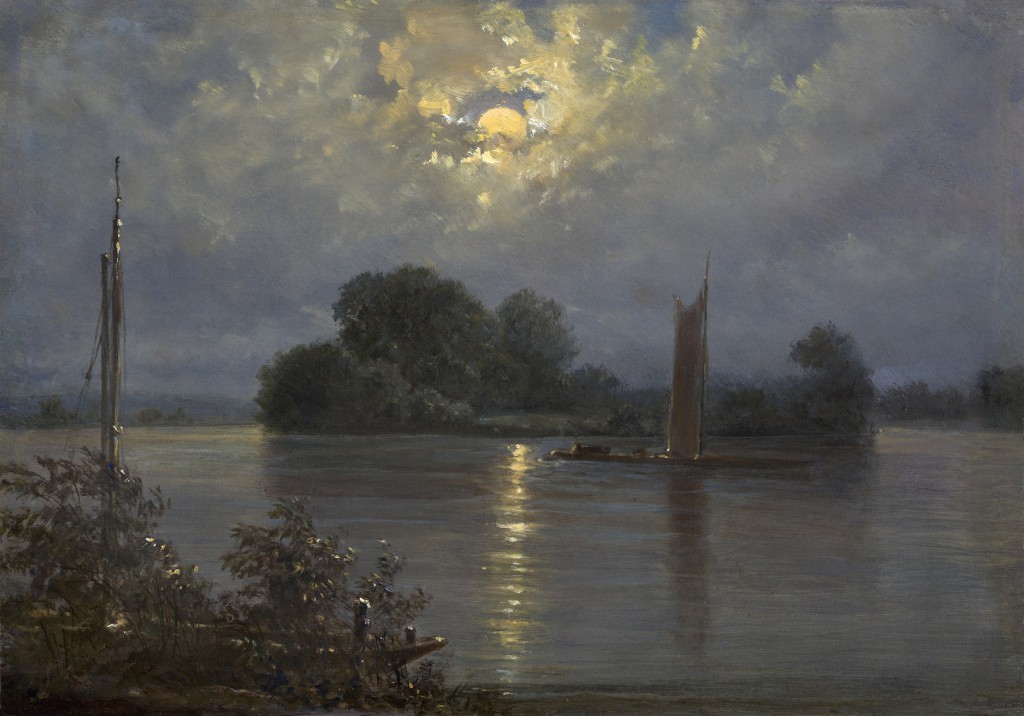Carl Gustav Carus
(1789 Leipzig - 1869 Dresden)
Moonlight on River Elbe at Pillnitz
Oil on cardboard, 17.8 x 25.4 cm
On the verso the address label of Windsor & Newton, London and the handwritten inscription Carus ‘Insel bei Pillnitz'.
Provenance:
Private collection, Dresden, thence by descent;
Private collection, North Rhine-Westphalia;
Private collection, New York.
A report by Professor Dr. Helmut Börsch-Supan, Berlin, accompanies the painting.
Most probably no. 289 in the catalogue raisonné by Marianne Prause.
Carl Gustav Carus was a man of many talents. A physician and natural scientist, he was active as a man of letters and a painter of outstanding ability. As an artist, he owed an important debt to Caspar David Friedrich, a close friend since 1817. Following Friedrich's lead, Carus played a prominent role in the German Romantic movement both as an artist and as an author of important theoretical writings. His Briefe zur Landschaftsmalerei are regarded as of seminal importance in the understanding of early nineteenth-century thinking about art. He kept faith with the natural world and filled his landscapes with powerful intensity of feeling.[1] He enjoyed a longstanding friendship with Goethe with whom he shared a dual interest in art and science.
Carus's preferred landscape motifs were, from the early 1930s, subjects sketched before nature in the surroundings of Pillnitz, near Dresden. He had purchased a country property near Schloss Pillnitz in 1832 and regularly explored the local countryside. He was personal physician to the Saxon Royal family, who spent their summers in Pillnitz and this obliged him to be close at hand.
Carus was greatly attracted by the diversity of plant life on a small island in the middle of the river Elbe opposite Schloss Pillnitz. Its untamed nature provided an interesting contrast to the formal park surrounding the Schloss. He made several trips to explore the island both by day and by night, sometimes visiting it in the company of friends.[2]
This small-format, finely-worked nocturnal river scene is representative of the sensibility of the Romantic era in its purest form. A full moon at the centre of the image is wreathed in cloud. Moonlight suffuses the clouds, gleaming across the smooth surface of the river. A sailing barge manned by a solitary figure glides through the water. A second barge, partly hidden by vegetation, is moored in the left foreground. The small, densely vegetated island at the centre of the image with its silvery accents has something of an enchanted, other-worldly quality.
Paul Ferdinand Schmidt, writing on Carus's paintings in 1928, noted: He combined precision of observation with a lively sensibility for the emotional tenor of night scenes. The depth of emotional feeling in his perception of the stillness of nature, the silent passage of the clouds and the play of moonlight on the gently rippling surface of the water is very much in evidence.[3]
To the Romantics, night was thought to be loaded with a wealth of positive overtones. Somewhat surprisingly, nightfall was thought to be accompanied by an expansion of intellectual horizons and a greater susceptibility to perceptive insights. Gotthilf Heinrich von Schubert, a natural philosopher, had given a series of lectures titled Ansichten von der Nachtseite der Wissenschaften in Dresden in 1808. In these lectures he developed the idea of a natural world in constant, interactive exchange with humanity. Carus, a natural scientist, was able to enhance straightforward observation of nature by depicting and conveying his emotional response at the same time. He melded findings and ideas drawn on physics, philosophy and poetry.[4] A man of many disciplines, Carus can be seen as an Idealfigur of the Romantic movement. He accorded maximum importance to scientific accuracy in his observation of the natural world and its physical phenomena before moving on to present these findings and ideas in an artistic idiom. His night scenes represent the intellectual core of his artistic oeuvre. In his final years at his house in Pillnitz he wrote: For another three weeks, back in this Pillnitz - the place where so much in my soul was to ripen, where [my] inner being has experienced the most marvellous of imaginary insights![5]
[1] Carus put forward a theoretical analysis of this interest in his Nine Letters on Landscape Painting [Neun Briefe über Landschaftsmalerei], written between 1815 and 1824 and published in 1831. Here he defined the depiction of a certain state of mind [feeling] by means of the reproduction of a corresponding mood in the life of nature [truth] as the central task of landscape art. Conditions in nature should correspond with the artist's emotions. Hinrich Sieveking in Fuseli to Menzel - Drawings and Watercolours in the Age of Goethe from a German Private Collection, exhib. cat., Munich and New York 1998, p. 180. [2] Frank Richter, Carl Gustav Carus. Der Malerfreund Caspar David Friedrichs und seine Landschaften. Dresden 2009, p. 47. [3] Paul F. Schmidt, Carl Gustav Carus. Der Mensch, der Arzt und Forscher, der Künstler, in Erich Haenel (ed.), Der grosse Garten. Hundert Jahre sächsischer Kunstverein. Jubiläums-Festschrift, Dresden 1928, p. 77. [4] Roger Cardinal, Nacht und Traum. Hymnen an die Nacht - Traum und Unbewußtes, in exhib. cat., Ernste Spiele. Der Gesicht der Romantik in der deutschen Kunst 1790-1990, Munich, Haus der Kunst; Edinburgh, Royal Scottish Academy; and London, Hayward Gallery, 1994-5, p. 538 ff. [5] Sächsische Landesbibliothek - Staats- und Universitätsbibliothek (SLUB) Dresden, Mscr. Dresd. App. 314, III, fol. 134 (Lebensbetrachtungen. Nachtrag zu den Lebenserinnerungen von C. G. Carus, cited after Gerd Spitzer, Dresden und Pillnitz, in exhib. cat., Carl Gustav Carus. Natur und Idee, Dresden, Staatliche Kunstsammlungen and Berlin, Staatliche Museen, Dresden and Berlin, 2009-10, p. 71 ff.

